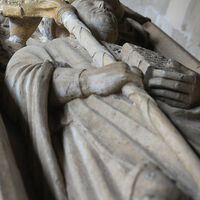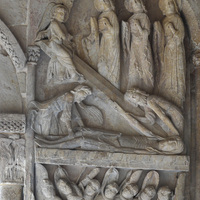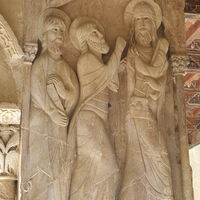Monastery of Santo Domingo de Silos
Type:
Monasteries,
Sculptures,
Cenotaphs
Date:
Eleventh and twelfth centuries, with later additions
Location or Findspot (Modern-Day Country):
Spain
Description:
Pilgrimage to the monastery of Santo Domingo de Silos (northern Spain) grew steadily at the end of the eleventh century, reaching its zenith in the twelfth century. The focal point of pilgrim veneration at the site was the tomb of Domingo Manso (1000–1073), an abbot credited for restoring the monastery after a period of neglect and deterioration. Domingo's work of restoring the monastery was continued by his successor Fortunius with patronage from Alfonso VI, king of the Castile and León (r. 1072–1109).
Around 1076, following Domingo's canonization, his body was moved from the north gallery of the cloister to the church, close to the western entrance through which the pilgrims would have entered. In the twelfth century, a porch was built along the north side of the church, increasing the standing space for the ever-growing numbers of pilgrims.
Domingo's original burial spot in the cloister was commemorated by a twelfth-century cenotaph, later topped with an effigy of Domingo in the thirteenth century. Nearby depictions (late eleventh or early twelfth century) of the Deposition and the Entombment on the northeast pier would have recalled in the monks' minds the original funerary function of the north gallery.
The relationship between the monks and the lay pilgrims to the site may be reflected in parts of the Doubting Thomas relief on the northwest pier of the cloister. Four diminutive figures along the battlements—two men blowing horns and two women clapping on disks—represent the outer, profane world set in contrast with the enclosed world where Christ reveals himself to the apostles behind closed doors.
The monks' view of the laity was not necessarily negative. A second relief sculpture, on the same northwest pier with the Doubting Thomas scene, depicts the Road to Emmaus. In this unusual image, Christ appears not only meeting with the pilgrims but also taking on the role himself, dressed as a contemporary pilgrim to Santiago with his immediately recognizable wallet and scallop shell. The image of Christ as a pilgrim may have invited the monks' sense of compassion for the pilgrims to their own site.
Around 1076, following Domingo's canonization, his body was moved from the north gallery of the cloister to the church, close to the western entrance through which the pilgrims would have entered. In the twelfth century, a porch was built along the north side of the church, increasing the standing space for the ever-growing numbers of pilgrims.
Domingo's original burial spot in the cloister was commemorated by a twelfth-century cenotaph, later topped with an effigy of Domingo in the thirteenth century. Nearby depictions (late eleventh or early twelfth century) of the Deposition and the Entombment on the northeast pier would have recalled in the monks' minds the original funerary function of the north gallery.
The relationship between the monks and the lay pilgrims to the site may be reflected in parts of the Doubting Thomas relief on the northwest pier of the cloister. Four diminutive figures along the battlements—two men blowing horns and two women clapping on disks—represent the outer, profane world set in contrast with the enclosed world where Christ reveals himself to the apostles behind closed doors.
The monks' view of the laity was not necessarily negative. A second relief sculpture, on the same northwest pier with the Doubting Thomas scene, depicts the Road to Emmaus. In this unusual image, Christ appears not only meeting with the pilgrims but also taking on the role himself, dressed as a contemporary pilgrim to Santiago with his immediately recognizable wallet and scallop shell. The image of Christ as a pilgrim may have invited the monks' sense of compassion for the pilgrims to their own site.
Relevant Textbook Chapter(s):
7
Repository and Online Resources:
• Visit the monastery's official website.
Image Credits:
Wikimedia Commons







